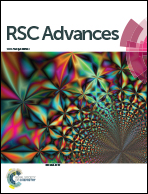Amplified electrochemical genotyping of single-nucleotide polymorphisms using a graphene–gold nanoparticles modified glassy carbon platform†
Abstract
The main challenges in the construction of DNA biosensors for the genotyping of all the possible single-nucleotide polymorphisms (SNPs) are their sensitivity, speed and cost. The application of nanoparticle-modified monobases for the electrochemical genotyping of SNPs has been investigated in our previous study. In the present manuscript, that strategy was modified by applying a graphene–gold nanoparticle (GR–AuNPs) nanocomposite to achieve further amplification and higher sensitivity of SNPs genotyping. The present strategy shows a good potential for sensitively discriminating, quantifying and genotyping different SNPs. Taking the advantages of triple-amplification effects of AuNPs, GR and modified metal (Au and Ag) nanoparticles, this DNA biosensor exhibits highly sensitive responses for the genotyping of different SNPs and the detection of thermodynamically stable SNP (G–T) and A–C mismatch targets in the range of 10–1700 pM and 20–1200 pM with the detection limits of 2 and 10 pM (3σ) for G–T and A–C mismatch targets, respectively. The results demonstrate that when the surface coverage of DNA per unit area is just slightly increased, there is a dramatic increase in the active surface area, and the absolute loading amount of DNA on the surface would also be increased.



 Please wait while we load your content...
Please wait while we load your content...